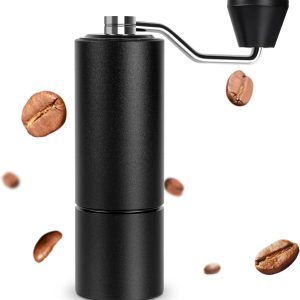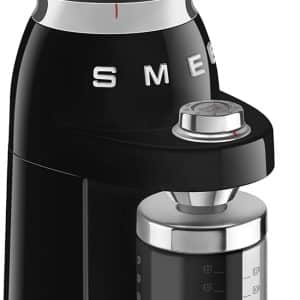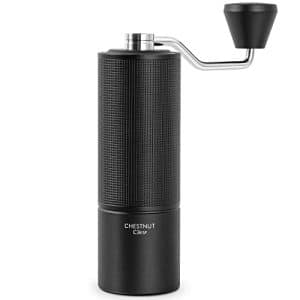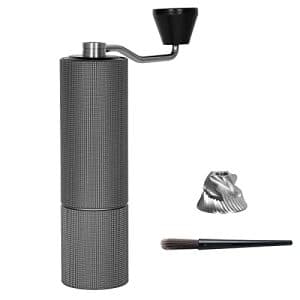Have you ever experienced a small electric shock while grinding your coffee?
Or noticed those pesky coffee grounds sticking to the sides of your grinder?
These peculiar occurrences can be attributed to the fascinating world of coffee grinder static electricity.
In this article, we will explore the mysteries behind this phenomenon and its impact on the coffee grinding process.
Get ready to uncover the secrets of coffee grinder static electricity and gain a deeper understanding of this intriguing phenomenon.
Understanding Coffee Grinder Static Electricity
Coffee grinder static electricity is a fascinating phenomenon that many coffee enthusiasts have encountered. It occurs when grinding coffee beans, leading to small electric shocks and the annoying clinging of coffee grounds to the grinder’s surfaces. To understand this phenomenon, we need to explore the science behind static electricity and its specific causes in the context of coffee grinding.
The Science of Static Electricity
Static electricity is the result of an imbalance of electric charges on the surface of objects. It occurs when two materials come into contact and then separate, causing the transfer of electrons between them. This transfer of electrons creates an electric charge imbalance, leading to static electricity. In the case of coffee grinding, the friction between the coffee beans and the grinder’s burrs generates static electricity.
Triboelectrification: The Culprit
The primary cause of coffee grinder static electricity is a phenomenon called triboelectrification. Triboelectrification refers to the transfer of electric charges that occurs when two materials come into contact and then separate. In the case of coffee grinding, the coffee beans and the grinder’s burrs are the materials involved in this process. As the beans are ground, the friction between them and the burrs causes the transfer of electrons, resulting in the accumulation of static charge.
The Role of Coffee Beans
Coffee beans themselves play a crucial role in the generation of static electricity. Coffee beans contain moisture, oils, and other compounds that can contribute to the build-up of static charge. When the beans are ground, these compounds interact with the grinder’s burrs, facilitating the transfer of electrons and the subsequent accumulation of static charge on the coffee grounds and the grinder’s surfaces.
Grinder Type and Static Electricity
The type of coffee grinder used can also influence the occurrence of static electricity. Blade grinders, which have a single blade that spins rapidly to chop the coffee beans, are more prone to static electricity compared to burr grinders. Blade grinders generate more heat and friction during the grinding process, leading to a greater build-up of static charge. On the other hand, burr grinders, which crush the beans between two abrasive surfaces, generate less heat and friction, reducing the occurrence of static electricity.
Environmental Factors
Environmental factors, such as humidity levels, can also affect the generation of static electricity during coffee grinding. Low humidity environments, often found in dry climates or during winter months, tend to exacerbate the occurrence of static charge. The lack of moisture in the air allows for easier electron transfer and accumulation of static charge on the coffee grounds and the grinder’s surfaces.
Managing Coffee Grinder Static Electricity
While coffee grinder static electricity can be a nuisance, there are ways to manage and minimize its effects. One simple solution is to introduce moisture into the grinding process. Spraying a small amount of water onto the coffee beans before grinding can help reduce the build-up of static charge. Additionally, using a burr grinder instead of a blade grinder can also help minimize static electricity due to their lower heat and friction generation. Regular cleaning and maintenance of the grinder can also prevent the accumulation of static charge.
In conclusion, coffee grinder static electricity is a result of the friction between coffee beans and the grinder’s burrs, leading to the transfer of electrons and the accumulation of static charge. Coffee beans’ moisture and compounds contribute to the generation of static electricity, while environmental factors like humidity levels can further enhance its occurrence. By understanding the science behind static electricity and implementing simple strategies, coffee enthusiasts can manage and minimize the effects of static electricity during the grinding process, ensuring a more enjoyable coffee experience.

The Impact of Coffee Grinder Static Electricity
Coffee grinder static electricity can have a significant impact on the coffee grinding process and the quality of the resulting brew. Understanding these effects is crucial for coffee enthusiasts who strive for a consistent and enjoyable coffee experience.
Uneven Ground Distribution
One of the primary effects of static electricity is the uneven distribution of coffee grounds. As static charge builds up during the grinding process, the coffee grounds can clump together, leading to an inconsistent distribution. These clumps may stick to the grinder’s surfaces or the sides of the container, resulting in an uneven extraction during brewing. This can lead to a less balanced and less flavorful cup of coffee.
Difficult Cleanup
Another effect of static electricity is the challenge it poses during cleanup. The clinging of coffee grounds to the grinder’s surfaces can make it difficult to remove them completely. Coffee enthusiasts often have to scrape off the grounds or use brushes to dislodge them, resulting in a messy and time-consuming cleanup routine. Additionally, the static charge can cause the grounds to scatter when transferring them to a brewing device, further adding to the cleanup hassle.
Accelerated Oxidation
Static electricity can also contribute to increased oxidation of the coffee grounds. When coffee grounds are exposed to air for an extended period, they begin to oxidize, leading to a loss of flavor and aroma. The clumping of grounds caused by static charge can create pockets of trapped air within the clumps, accelerating the oxidation process. This can result in a less vibrant and less satisfying cup of coffee.
Potential Discomfort and Hazards
While the effects of coffee grinder static electricity are primarily related to the quality of the brew, it is worth considering potential discomfort and hazards. Although the electric shocks experienced during coffee grinding are typically mild, repeated exposure to static electricity can cause irritation and discomfort. It is important to take precautions and ensure proper grounding of electrical components to minimize the risk of electric shocks.
Mitigating the Effects of Static Electricity
Fortunately, there are strategies that can help mitigate the effects of static electricity during the grinding process. One effective method is to introduce moisture into the coffee beans before grinding. Spraying a small amount of water onto the beans can help reduce the build-up of static charge, resulting in less clumping and a more even distribution of grounds. Additionally, using anti-static accessories such as brushes or containers can help minimize the impact of static electricity. Regular cleaning and maintenance of the grinder are also essential to prevent the accumulation of static charge.
In conclusion, coffee grinder static electricity can have a significant impact on the coffee grinding process and the quality of the brew. It can lead to uneven ground distribution, difficult cleanup, accelerated oxidation, and potential discomfort or hazards. However, by implementing strategies such as introducing moisture, using anti-static accessories, and maintaining the grinder properly, coffee enthusiasts can mitigate the effects of static electricity and enjoy a more consistent and flavorful cup of coffee. Understanding the impact of static electricity and taking proactive measures can enhance the overall coffee brewing experience.
Practical Tips for Managing Coffee Grinder Static Electricity
Dealing with coffee grinder static electricity can be a frustrating experience for coffee enthusiasts. However, there are several practical tips and techniques that can help minimize its impact and make the coffee grinding process more enjoyable. Here are some suggestions to consider:
1. Introduce Moisture to the Coffee Beans
One effective way to reduce static electricity during grinding is to introduce moisture to the coffee beans. Lightly misting the beans with water using a spray bottle before grinding can help mitigate the build-up of static charge. However, it’s important to be cautious and avoid adding too much moisture, as it can affect the flavor and consistency of the grounds. The goal is to add just enough moisture to minimize static electricity without compromising the quality of the coffee.
2. Utilize an Anti-Static Brush
An anti-static brush can be a useful tool for dealing with static electricity in coffee grinders. After grinding the coffee beans, use the brush to gently sweep away any clinging grounds from the grinder’s surfaces. The bristles of the brush help neutralize the static charge and prevent the grounds from sticking. Regularly cleaning the grinder with an anti-static brush can significantly reduce the mess and make the cleanup process more efficient.
3. Tap or Shake the Grinder
A simple technique to minimize static electricity is to tap or shake the grinder gently after grinding the beans. This helps dislodge any clinging grounds and allows them to fall into the collection container or brewing device. By giving the grinder a few taps or shakes, you can reduce the chances of grounds sticking to the surfaces and improve the overall distribution of the grounds.
4. Store Coffee Beans Properly
Proper storage of coffee beans can also help minimize static electricity during grinding. It is best to store coffee beans in airtight containers that are not prone to static charge. Avoid using plastic containers or bags, as they can generate static electricity. Instead, opt for glass or stainless steel containers that provide a more neutral environment. Additionally, storing the beans in a cool, dry place can help maintain their freshness and reduce the chances of static charge accumulation.
5. Consider Grinding in Small Batches
If you frequently experience excessive static electricity during grinding, consider grinding your coffee beans in smaller batches. Grinding a smaller amount of beans at a time reduces the overall friction and heat generated, which can help minimize static charge build-up. While this may require more frequent grinding sessions, it can significantly reduce the impact of static electricity on the coffee grounds and the grinder’s surfaces.
6. Pre-Infusion of Coffee Grounds
Another technique to mitigate static electricity is to pre-infuse the coffee grounds before brewing. Pre-infusion involves pouring a small amount of hot water over the grounds and allowing them to bloom for a short period. This step helps release any trapped air within the grounds and reduces the chances of static charge affecting the extraction process. After pre-infusion, continue with your preferred brewing method to enjoy a more consistent and flavorful cup of coffee.
7. Regular Maintenance of the Grinder
Regular maintenance of your coffee grinder is essential to prevent the accumulation of static charge. Clean the grinder thoroughly after each use, ensuring that all residual grounds are removed. Pay close attention to the areas where grounds tend to cling, such as the burrs and the chute. Additionally, lubricate the moving parts of the grinder as recommended by the manufacturer to ensure smooth operation and minimize friction that can contribute to static electricity generation.
Experiment and Find What Works Best for You
It’s important to remember that different coffee grinders and environments may require different approaches to manage static electricity. Experiment with these tips and techniques to find the methods that work best for you. By implementing these strategies, you can minimize the impact of static electricity and enjoy a smoother and more enjoyable coffee grinding experience.
In conclusion, coffee grinder static electricity is a fascinating phenomenon that can have a significant impact on the coffee grinding process and the quality of the resulting brew. The friction between the coffee beans and the grinder’s burrs leads to the generation of static charge, causing the grounds to clump together and stick to the grinder’s surfaces. This uneven distribution of grounds can result in inconsistent extraction and a less flavorful cup of coffee. Additionally, the mess and cleanup hassle caused by static electricity can be frustrating for coffee enthusiasts.
However, by implementing practical tips such as introducing moisture to the beans, using anti-static brushes, tapping or shaking the grinder, storing beans properly, grinding in small batches, pre-infusing the grounds, and maintaining the grinder regularly, coffee enthusiasts can minimize the impact of static electricity and enjoy a more consistent and enjoyable coffee grinding experience. These strategies help to reduce clumping, improve ground distribution, and prevent excessive oxidation of the coffee grounds.
It is important for coffee enthusiasts to experiment with these techniques and find the methods that work best for their specific grinder and environment. By taking proactive measures to manage static electricity, coffee lovers can achieve a more balanced and flavorful cup of coffee, free from the frustrations of uneven distribution and messy cleanup.
So, why settle for a subpar coffee experience when you can take control and enhance the quality of your brew? Are you ready to elevate your coffee grinding game and bid farewell to the challenges posed by static electricity? Embrace the power of moisture, anti-static brushes, and proper maintenance to ensure a consistent and flavorful cup of coffee every time. With these strategies in your arsenal, you can conquer the static electricity challenge and enjoy the perfect cup of coffee that you deserve.
Are you ready to take your coffee brewing to the next level?






